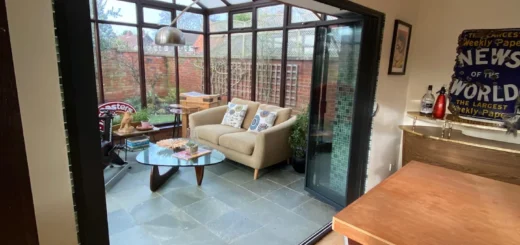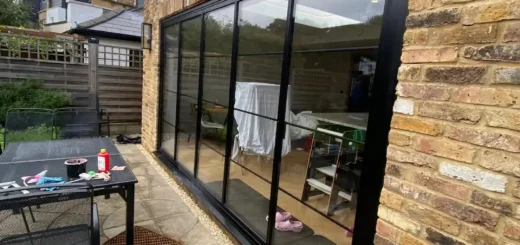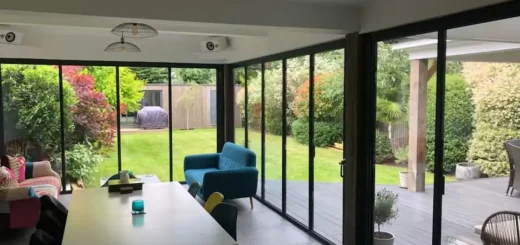A Guide to Choosing Glass Living Room Internal Sliding Doors
Table of Contents
Types of Glass Sliding Doors for Living Rooms
Glass living room internal sliding doors come in various styles, each offering unique benefits for your home. These doors can really change how you use your living space, providing flexibility and a fresh look.
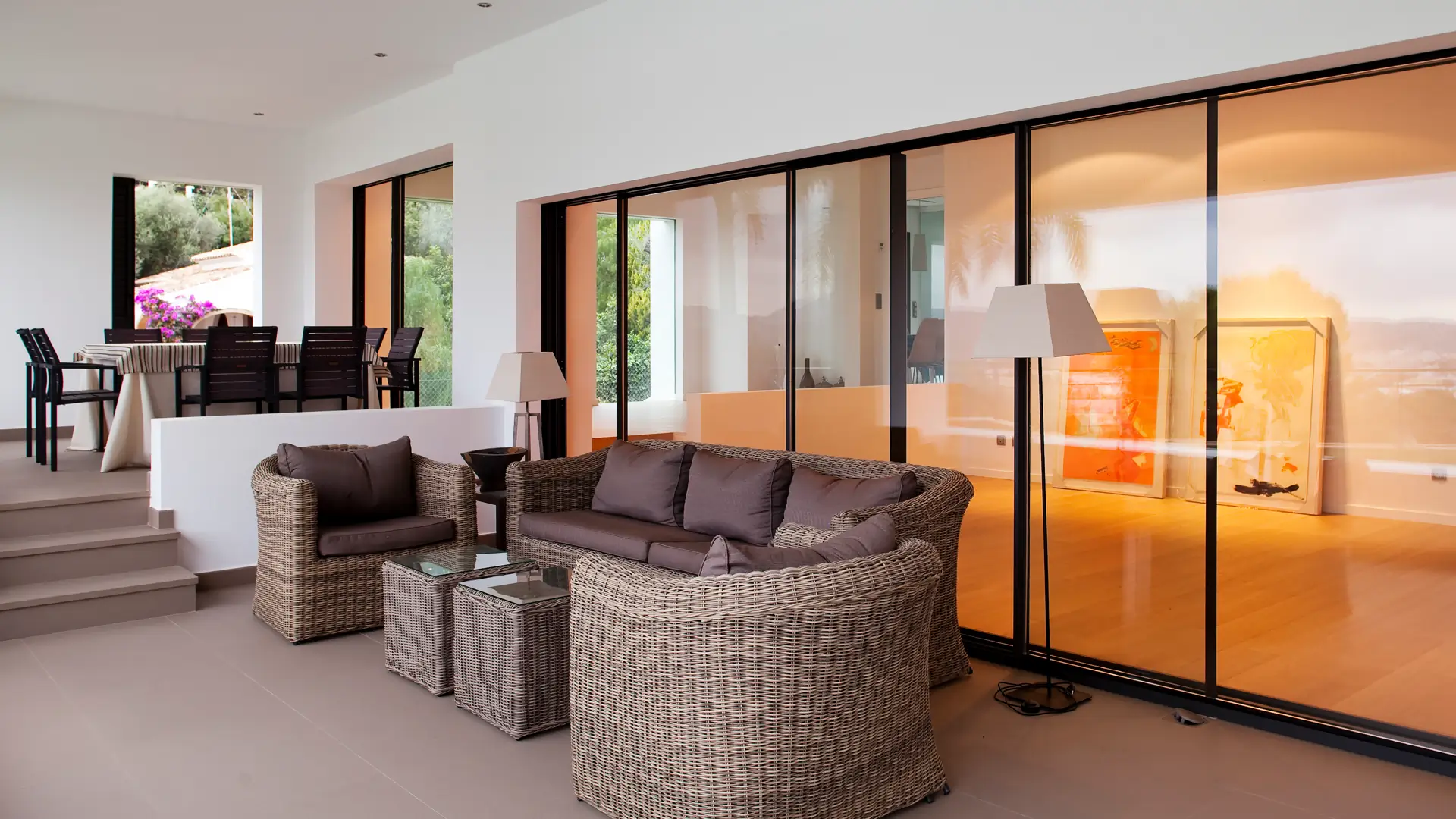
Framed vs Frameless Glass Doors
The choice between framed and frameless glass sliding doors for living rooms can have a big impact on your room’s appearance. Framed doors feature visible borders around the glass panels, often made of aluminium, wood, or uPVC. These frames can add structure and definition to your living area, especially in larger spaces where you want to create distinct zones.
Frameless internal glass doors (also known as frameless room dividers), on the other hand, offer an even more minimalist look. Without visible borders, they create an uninterrupted view, making your living room feel more open and spacious. This style works particularly well in smaller living areas or where you want to maintain a sense of continuity between spaces. However, they are typically more expensive.
Materials
For living room internal sliding doors, aluminium is a popular choice. It’s lightweight, durable, and requires little maintenance – ideal for busy family homes. Wooden frames bring warmth and character, complementing traditional or rustic living room décor.
Frameless doors rely on high-quality glass and robust fittings to ensure safety and smooth operation. The absence of a frame means the glass itself becomes a key design feature in your living room.
Single vs Multi-panel Systems
The number of panels in your glass living room internal sliding doors can affect both function and style. Single panel doors are straightforward and effective, ideal for smaller openings or where you want a clean, uncluttered look. They slide neatly to one side, requiring minimal space to operate.
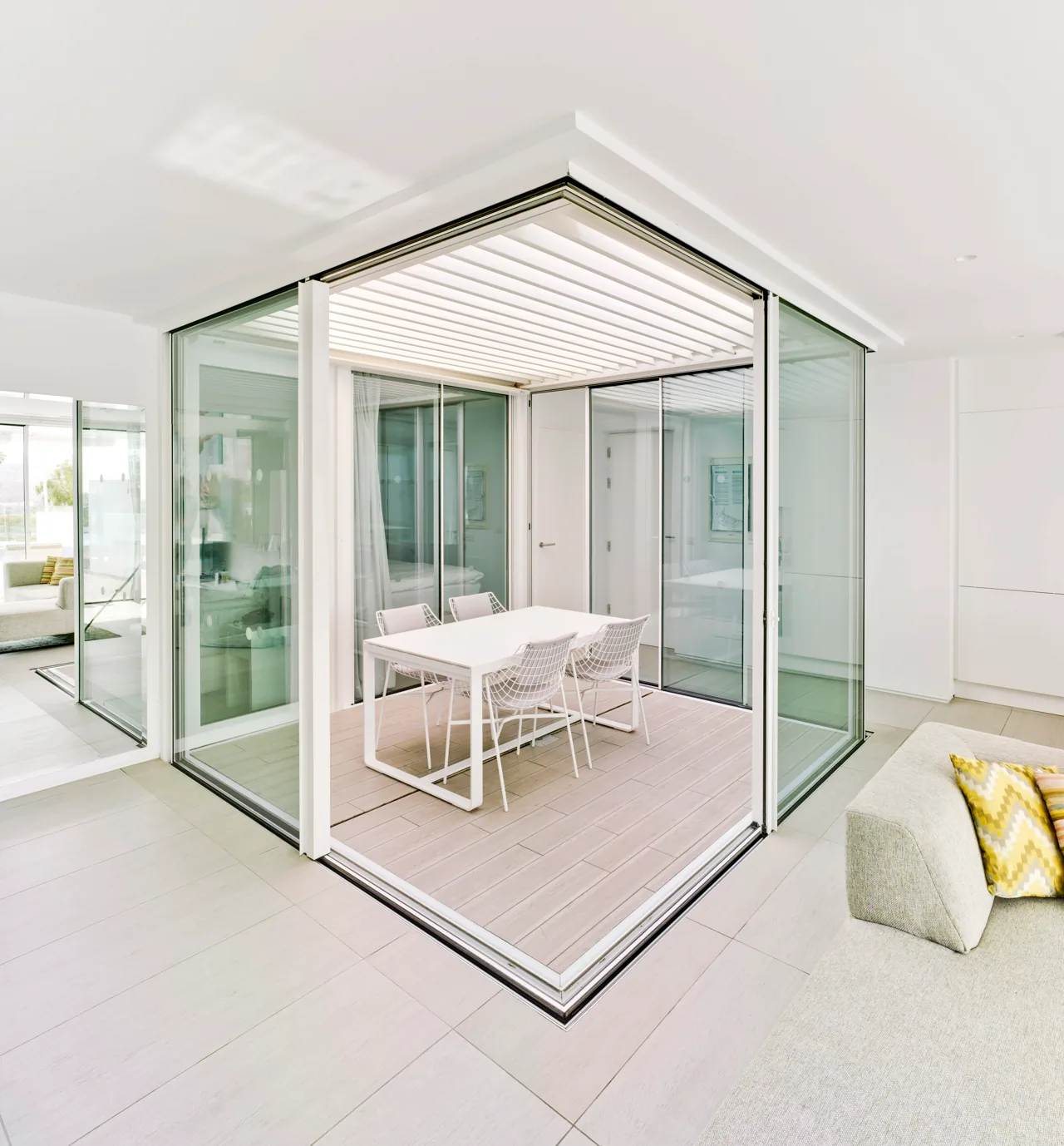
Multi-panel systems offer more flexibility. These sliding living room doors can divide larger spaces or create wide openings between rooms. With two, three, or more panels, you can adjust the opening size to suit different occasions. For example, you might fully open the doors when hosting a party, partially open them for everyday use, or close them completely for privacy or to separate heating zones.
When choosing between single and multi-panel sliding doors for living rooms, think about your available wall space. Single panels need enough adjacent wall area to slide back fully. Multi-panel systems can fold back on themselves, taking up less wall space when fully open.
The track system is another factor to consider. Top-hung tracks are popular for living room sliding doors as they create a seamless floor step. However, they require a sturdy upper frame to support the weight. Bottom-rolling systems distribute the weight more evenly but may require a visible floor track.
Choosing Door Frames for Living Areas
The frames of your glass living room internal sliding doors play a role in both aesthetics and functionality. They can complement or contrast with your existing decor, while also providing structural support for the glass panels.
Frame Materials for Living Rooms
Aluminium frames are a common choice for interior sliding doors in living rooms. They’re lightweight yet strong, making them ideal for large glass panels. Aluminium frames can be powder-coated in a wide range of colours, allowing you to match or contrast with your living room’s colour scheme. These frames are also low-maintenance, requiring little more than occasional cleaning to keep them looking their best.
Wooden frames offer a warm, natural look that can soften the appearance of glass living room internal sliding doors. They work particularly well in traditional or rustic-style living rooms, adding character and texture. Oak, pine, and walnut are popular choices, each bringing its own unique grain patterns and colours to your living space. Keep in mind that wooden frames may require more upkeep than aluminium, including periodic treatment to protect against moisture and wear.
Hybrid Options
Some manufacturers offer hybrid frame materials, combining the strengths of different materials. For example, you might find sliding doors for living rooms with aluminium cores wrapped in wood veneer. This gives you the low-maintenance benefits of aluminium with the aesthetic appeal of wood.
Frame Colours and Living Room Decor
The colour of your door frames can have a big impact on your living room’s overall look. White frames are a classic choice, offering a clean, bright appearance that works well in most settings. They can make your living room sliding door blend with white walls or create a crisp contrast against darker colours.
Black frames make a bold statement, defining the door’s shape and creating a striking contrast with the glass. This can work particularly well in modern or monochrome living room designs. Black frames can also help to highlight views through the glass, acting like a picture frame for the space beyond.
For a subtler look, consider frames in neutral tones like grey or beige. These can complement a wide range of living room colour schemes without drawing too much attention to the doors themselves. Glass living room internal sliding doors with neutral-coloured frames can provide a sophisticated backdrop to your living space, allowing other design elements to take centre stage.
Metallic Finishes
Metallic frame finishes can add a touch of luxury to your living room sliding doors. Brushed nickel or chrome can create a sleek, modern look, while bronze or copper finishes can add warmth and richness. These metallic tones can tie in with other hardware in your living room, such as light fittings or furniture details, creating a cohesive design scheme.
Advice for Sliding Doors in Living Rooms
Natural Light and Living Spaces
One of the primary benefits of sliding doors for living rooms is their ability to let in plenty of natural light. Large glass panels allow sunlight to penetrate deeper into your home, creating a brighter, more open atmosphere. This can be particularly beneficial in UK homes, where grey skies often necessitate making the most of available light.
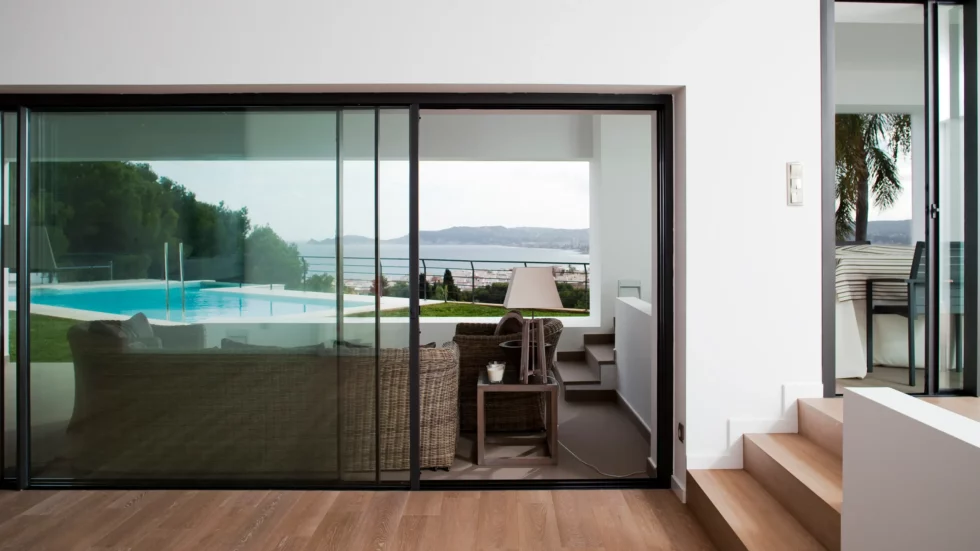
In south-facing living rooms, glass sliding doors can dramatically increase the amount of sunlight entering the space. This natural warmth can be a boon in winter months, potentially reducing heating costs. However, it’s worth considering whether the increased light might cause glare on screens or fade furniture and carpets over time.
For north-facing rooms, living room sliding doors can help to distribute limited natural light more effectively. By replacing solid walls with glass, you can borrow light from adjacent spaces, making the room feel larger and more inviting.
Seasonal Variations
Remember that the impact of glass living room internal sliding doors on natural light will vary throughout the year. In summer, when the sun is higher in the sky, they might allow more direct sunlight into your living space. In winter, with the sun lower on the horizon, the light entering through your sliding living room doors will be more oblique.
Temperature Control in Living Areas
While glass doors can bring more natural light into your living room, they can also affect the room’s temperature. Modern double or triple-glazed sliding doors offer good insulation, but they may not be as effective as a solid wall at keeping heat in during cold weather.
In summer, large glass areas can lead to overheating if not properly managed. South-facing glass living room internal sliding doors might allow too much heat into the space on sunny days. Consider incorporating blinds, curtains, or even specialised solar control glass to manage heat gain.
Conversely, in winter, glass doors can create cold spots in your living room if not properly insulated. Look for doors with thermal breaks in the frames and high-quality weatherstripping to reduce heat loss. Some sliding doors for living rooms come with low-emissivity (low-E) coatings that reflect heat back into the room, helping to keep it warm.
Ventilation Options
Many living room sliding door systems include options for ventilation. This might be a small opening section within a larger fixed panel, or the ability to slide the door open just a few inches. These features can be useful for controlling temperature and fresh air flow in your living space without fully opening the doors.
When choosing glass living room internal sliding doors, think about how you use your living space throughout the year. Do you often have large gatherings where you’d want to open the doors fully? Or do you prefer a cosier atmosphere with more controlled ventilation? Your lifestyle and preferences should guide your choice of door system and any additional features like built-in blinds or specialised glass coatings.
Furniture and Glass Door Compatibility
Arranging Living Room Furniture
When planning your furniture layout around sliding doors for living rooms, consider both aesthetics and practicality. Start by ensuring there’s enough clearance for the doors to open fully without obstruction. This might mean keeping larger pieces like sofas and bookcases away from the door’s sliding path.
Low-profile furniture often works well with glass sliding doors, as it doesn’t block light or views. Consider placing a low-backed sofa or armchairs parallel to the doors, creating a comfortable seating area that faces the glass. This arrangement allows you to enjoy any views beyond the doors while maintaining an open feel in the room.
If your living room sliding door leads to an outdoor space, you might want to create a flow between indoor and outdoor areas. Position indoor furniture to mirror outdoor seating arrangements, visually connecting the two spaces when the doors are open.
Multifunctional Spaces
Glass living room internal sliding doors are particularly useful in open-plan areas where you might want to create distinct zones. Use furniture to delineate different areas – for example, a dining table near the doors can create a transition between living and dining spaces. When the internal doors are closed, the glass still allows visual connection between zones while providing some separation.
Choosing Complementary Furniture Styles
The style of your furniture can either contrast or complement your sliding living room doors. For a cohesive look, choose furniture with clean lines and minimal ornamentation to echo the sleek appearance of glass doors. Modern or Scandinavian-style pieces often work well in this context.
If your living room has a more traditional style, you can still incorporate glass sliding doors effectively. Choose furniture with softer lines and richer textures to balance the doors’ modern appearance. A plush armchair or a wooden coffee table with intricate detailing can add warmth and character to the space.
Consider how your furniture colours work with the door frames. If you have dark-framed sliding doors for living rooms, light-coloured furniture can create a striking contrast. On the other hand, if your door frames are light or neutral, you have more flexibility with furniture colours.
Flexible Furniture Solutions
Given that glass living room internal sliding doors can change the dynamics of your space, consider incorporating flexible furniture solutions. Modular sofas, for instance, can be rearranged to suit different layouts. Nested tables or ottomans with hidden storage can be easily moved when you want to open the doors fully.
Light, easily movable pieces like side tables or floor lamps can be particularly useful. They allow you to quickly adjust your living room layout when you want to make the most of your sliding doors, whether you’re hosting a party or just enjoying a sunny day.
Remember that your furniture choices can affect how light moves through the space. Glass-topped tables or mirrored surfaces can help bounce light around the room, amplifying the brightening effect of your sliding living room doors. Dark, heavy furniture might absorb light, potentially counteracting some of the benefits of your glass doors.
Living Room Privacy Solutions
While glass living room internal sliding doors offer numerous benefits, they can also present privacy challenges. Fortunately, there are several ways to balance openness with privacy, allowing you to enjoy the best of both worlds.
Curtains and Blinds with Glass Doors
Curtains are a classic solution for adding privacy to sliding doors in living rooms. They offer flexibility, allowing you to completely open them for an unobstructed view or close them for total privacy. When selecting curtains, consider their weight and how they’ll hang when the doors are open. Lighter fabrics can create a softer look and are easier to manage, while heavier curtains might provide better insulation and light blocking.
For a more modern approach, blinds can be an excellent option for living room sliding doors. Vertical blinds are particularly well-suited, as they echo the vertical lines of the door panels and can be easily pushed to one side when not in use. Venetian blinds offer precise control over light and privacy, allowing you to adjust the slats to your preferred angle.
Innovative Solutions
Some glass living room internal sliding doors come with built-in blinds (integral blinds) sandwiched between the glass panes. These offer a sleek, low-maintenance solution that doesn’t interfere with the door’s operation. They’re particularly useful in high-traffic areas where traditional curtains or blinds might get in the way.
Creative Screening Options
If you want to maintain some visibility while still adding a degree of privacy, consider using decorative screens. These can be placed in front of your sliding doors for living rooms, creating an interesting visual feature while obscuring direct views. Folding screens offer flexibility, as they can be easily moved when you want full access to the doors.
For a more permanent solution, you might consider applying decorative window film to your glass living room internal sliding doors. These films come in a variety of patterns and opacities, allowing you to customise the level of privacy while still letting light through. Some films even create stained glass effects, adding a pop of colour to your living space.
Natural Screening
Plants can provide a natural, living privacy screen for your sliding living room doors. Tall potted plants or a row of smaller plants on a narrow console table can create a green barrier that softens the look of the glass while providing subtle screening. This approach works particularly well if your doors lead to an outdoor space, creating a visual link between indoor and outdoor greenery.
Remember that privacy needs may change depending on the time of day or season. In summer, when you’re more likely to have the doors open, you might rely more on outdoor screening like trellises or strategic landscaping. In winter, when the doors are usually closed, indoor solutions like curtains or blinds become more important.
Acoustic Properties in Living Spaces
When installing glass living room internal sliding doors, it’s important to consider their impact on sound transmission within your home. While these doors can create a visually open space, they may not provide the same level of sound insulation as traditional solid doors.
Sound Insulation for Family Areas
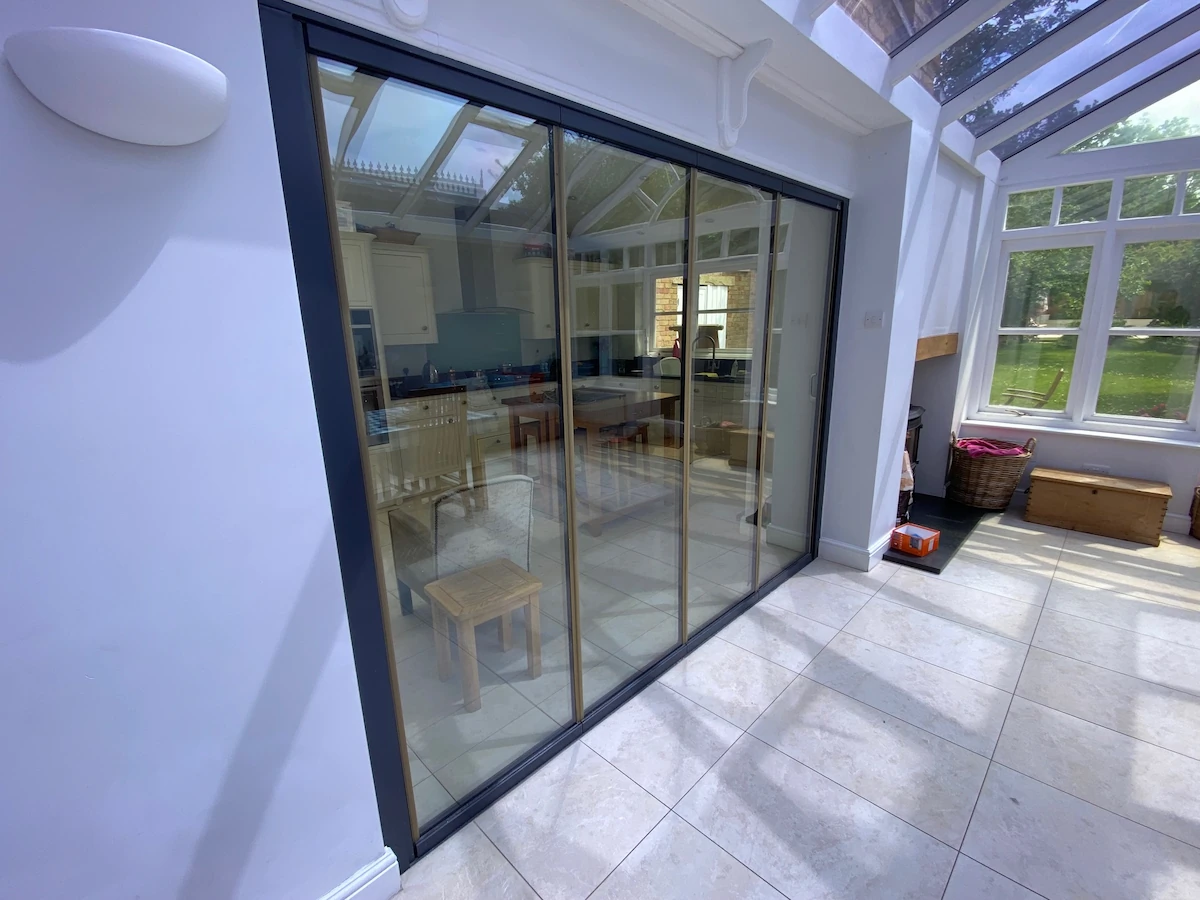
Standard single-pane glass offers limited sound insulation, which might be an issue if you’re using sliding doors for living rooms to separate noisy areas from quieter ones. However, modern glass technology has made huge strides in improving the acoustic performance of sliding doors.
Double or triple-glazed sliding living room doors can substantially reduce sound transmission. These doors feature multiple layers of glass with air or gas-filled spaces between them, which help to absorb and dampen sound waves. The thickness of the glass panes and the width of the air gaps can be adjusted to optimise sound insulation.
Laminated Glass for Noise Reduction
For even better acoustic performance, consider glass living room internal sliding doors with laminated glass. This type of glass incorporates a layer of polyvinyl butyral (PVB) between two or more sheets of glass. The PVB layer not only improves safety by holding the glass together if it breaks but also provides excellent sound insulation.
Some manufacturers offer specially designed acoustic glass for sliding doors in living rooms. This glass is engineered to reduce specific frequencies of sound, making it particularly effective at blocking out common household noises like television sound or conversations.
Managing Open-Plan Acoustics
In open-plan living areas, glass sliding doors can help to manage acoustics by providing a flexible barrier between spaces. When closed, they can help to contain noise from one area, such as a TV in the living room, while still maintaining visual connection with adjacent spaces.
However, it’s worth noting that glass living room internal sliding doors may not completely eliminate sound transfer, especially if there are gaps around the edges. High-quality seals and proper installation are vital for maximising the acoustic benefits of your sliding doors.
Complementary Acoustic Solutions
To further improve the acoustic properties of your living space, consider combining your sliding living room doors with other sound-absorbing elements. Soft furnishings like curtains, rugs, and upholstered furniture can help to absorb sound and reduce echoes in the room.
If your glass sliding doors separate your living room from a particularly noisy area, you might want to consider using them in conjunction with a solid door. This creates an airlock effect, reducing sound transmission while still allowing you to open up the space when desired.
Remember that the acoustic performance of glass living room internal sliding doors can vary widely depending on the specific product and installation. If sound insulation is a priority for your living space, it’s worth consulting with a specialist who can recommend the best options for your particular needs and budget.
Maintenance for High-Use Areas
Glass living room internal sliding doors require regular care to keep them functioning smoothly and looking their best. Proper maintenance of sliding doors not only prolongs the life of your doors but also ensures they continue to add value to your living space.
Cleaning Living Room Glass Doors
Regular cleaning is key to maintaining the appearance of your sliding doors for living rooms. Dust and fingerprints can quickly accumulate on glass surfaces, especially in busy family areas. A simple solution of warm water and mild dish soap, applied with a soft, lint-free cloth, is often sufficient for routine cleaning.
For tougher stains or built-up grime, you might need to use a specialised glass cleaner. However, be cautious with ammonia-based products, as they can damage some types of glass coatings. Always check the manufacturer’s recommendations before using any cleaning products on your glass living room internal sliding doors.
Don’t forget to clean the tracks as well. Debris in the tracks can impede smooth operation and potentially damage the door mechanism over time. Use a vacuum cleaner with a narrow nozzle attachment to remove loose dirt, then wipe the tracks with a damp cloth. For stubborn dirt, an old toothbrush can be useful for scrubbing the tracks clean.
Caring for Frames and Hardware
The frames of your living room sliding doors need attention too. For aluminium frames, regular dusting and occasional wiping with a damp cloth is usually sufficient. Wooden frames might require periodic treatment with appropriate wood care products to protect them from moisture and wear.
Pay special attention to the rollers and other moving parts of your sliding living room doors. These components bear the brunt of daily use and can wear out over time. Regularly inspect them for signs of wear or damage, and lubricate them as recommended by the manufacturer to ensure smooth operation.
Long-term Care
While glass living room internal sliding doors are generally durable, they can benefit from periodic professional maintenance. This might include adjusting the alignment of the doors, replacing worn rollers, or updating weatherstripping to maintain energy efficiency.
Living Room-Specific Design Ideas
Glass living room internal sliding doors offer numerous design possibilities, allowing you to create a space that’s both functional and visually appealing. By considering your specific needs and aesthetic preferences, you can use these doors to dramatically improve your living area’s look and feel.
Open-Plan Living with Glass Dividers
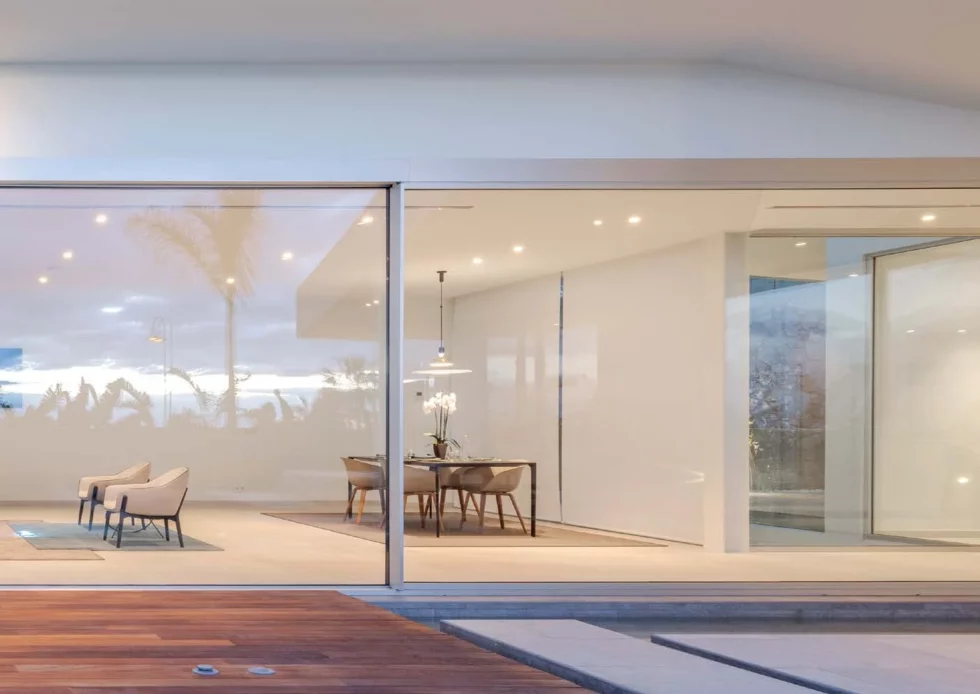
In many modern homes, open-plan living is highly desirable. Sliding doors for living rooms can help achieve this while still providing the option for separate spaces when needed. For instance, you might use glass sliding doors to divide your living room from a dining area or kitchen. When open, these doors create a flowing, spacious feel. When closed, they maintain visual connection while reducing noise and cooking odours.
Consider using frosted or patterned glass for these dividing doors. This approach allows light to pass through while offering a degree of privacy. It’s particularly useful if you want to hide clutter in one area while entertaining in another. Glass living room internal sliding doors with varying levels of opacity can create interesting visual effects as you move through the space.
In homes where natural light is at a premium, strategic placement of living room sliding doors can make a big difference. If your living room has limited windows, consider installing internal glass doors to borrow light from brighter adjacent spaces. This technique works especially well when connecting a living room to a conservatory or a bright hallway.
For a truly dramatic effect, floor-to-ceiling sliding doors can create a stunning feature wall of glass. This works particularly well if your living room overlooks a garden or courtyard, effectively bringing the outdoors in. Remember to balance this abundance of light with appropriate window treatments for privacy and light control.
Period Home Adaptations
Integrating glass living room internal sliding doors into period properties requires careful thought to maintain the home’s character. In Victorian or Edwardian homes, consider using doors with traditional frame styles and perhaps stained or etched glass patterns that echo period designs. This approach allows you to add modern functionality while respecting the property’s heritage.
For more minimalist period interiors, such as mid-century modern homes, sleek frameless glass sliding doors can complement the clean lines and open spaces typical of this style. The key is to choose doors that harmonise with your home’s existing architectural features.
Creating Multifunctional Spaces
Sliding doors for living rooms can be used to create flexible, multifunctional spaces. For example, you might use them to close off a home office nook within your living room. When work is done, simply slide the doors open to reclaim the full living space. This approach is particularly valuable in smaller homes where space is at a premium.
Another idea is to use glass living room internal sliding doors to create a temporary guest room. A set of double sliding doors can partition off part of a large living room, creating a private sleeping area when needed. The glass doors ensure the space doesn’t feel cramped or cut off from the rest of the home.
About SunSeeker Doors
With over 20 years of experience, SunSeeker Doors remains at the forefront of door design with our quality-tested patio doors and related products, including the bespoke UltraSlim aluminium slide and pivot door system, Frameless Glass Doors, and Slimline Sliding Glass Patio Doors. All of our doors are suitable for both internal and external use.
To request a free quotation, please use our online form. You may also contact 01582 492730, or email info@sunseekerdoors.co.uk if you have any questions.


